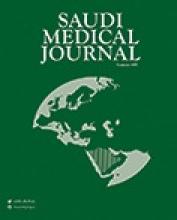Abstract
OBJECTIVE: To estimate the frequency of abnormal cervical smears and to compare the findings with earlier reported data from Saudi Arabia.
METHODS: The study was divided into 2 parts. The prospective part was conducted at King Abdul-Aziz University Hospital and a private laboratory by using the Bethesda System criteria and diagnostic entities in evaluating all the pap smears that were received during the period of January 2000 to December 2004. All reliable published literature on pap smear performed at different hospitals from 1990-2004, from the Western and Abha regions of Saudi Arabia were retrospectively evaluated.
RESULTS: A total of 5132 cases were evaluated in the prospective part of the study. The percentage of abnormal pap smears was 4.7%. The significant categories were atypical squamous cell of undetermined significance (2.4%), low grade squamous intraepithelial lesion (0.6%), high grade squamous intraepithelial lesion (0.4%) and atypical glandular cells of undetermined significance (1.1%). The malignant categories were squamous cell carcinoma (0.08%), adenocarcinoma of cervix in situ (0.02%) and invasive (0.04%). Other malignancies were 0.04% and neuroendocrine carcinoma was 0.02%. In the second part of the study, the total number of cases reported in the literature were 45596. The percentage of abnormal pap smear was1.4 %. The total cases evaluated in the current study and the previous published studies were 50,728 and the frequency of abnormal pap smear was 1.6%.
CONCLUSION: The percentage of abnormal pap smear was higher in the prospective part of this study than the previously reported results. Unified national programs for diagnosing cervical precancerous lesions should be established covering different region of the Kingdom to evaluate the magnitude of the problem.
- Copyright: © Saudi Medical Journal
This is an open-access article distributed under the terms of the Creative Commons Attribution-Noncommercial License (CC BY-NC), which permits unrestricted use, distribution, and reproduction in any medium, provided the original work is properly cited.






